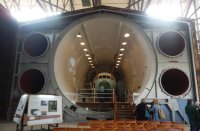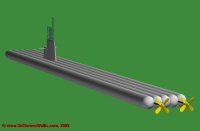Other Projects
As an engineer very well read in many aspects of science and the arts, Wallis was able to turn his mind very constructively to a wide range of problems. These included the following:
The Stratosphere Chamber
To support his (and other) work on the problems of high flying aircraft, Wallis in 1945 proposed the construction of a test chamber to simulate the temperatures and pressures for a wide range of flight conditions. This was a well-insulated chamber, large enough to hold a large section of an aircraft, which could be heated or refrigerated, and the internal pressure reduced to near-vacuum. This proved invaluable in a range of aircraft tests, and other contract work on vehicles, ships and plant was conducted in the chamber. Too expensive to demolish when British Aerospace left the site in the 1980s, it still exists as part of the Brooklands Museum, in the large building next to the clubhouse. An award of £120,000 made in 2012 allowed the building and the chamber to be refurbished, and new interpretation materials produced; the refurbished chamber opened to the public in March 2014.
Telescopes
Invited to design a mounting for the Isaac Newton (optical) telescope, Wallis produced a design for the whole telescope and the building to put it in, but his design was not taken up. His ideas later fed into a design for a large radio telescope, which was adopted for the Parkes Telescope in New South Wales, Australia. Completed in 1961, it included a dish with a geodetic structure and a mounting of novel Wallis design, both of which are still in use today. The telescope’s “finest hour” was receiving part of the first TV broadcast from the Moon.
Momentum Bombing
By the mid-1950s, air-dropped nuclear weapons were the deterrent weapon of choice for the superpowers, but developments in surface-to-air missiles were making high-flying bombers vulnerable. Low-level attacks became favoured, but this left the problem of releasing a nuclear bomb from low level while allowing the dropping aircraft to escape. As an alternative to the “toss bombing” technique which was developed (and which still opened up the bomber to the target defences in the last stage of the attack), Wallis proposed a “momentum bomb”. The small, unpowered, winged bomb would be mounted “piggy back” on the bomber, which would fly past its target at supersonic speed. The bomb would then be released, whereupon it would fly a backwards half-loop arriving over the target, while the bomber continued safely away from the target at high speed. Although the concept was considered feasible by the RAE, it was never put into practice.
Submarines
To avoid detection by surface ships, in the mid-1960s Wallis proposed a fast, deep-diving submarine. The high pressures would be met by a novel Wallis hull structure based on several interconnecting cylinders of small diameter, rather than the single large cylindrical pressure hull used on contemporary (and modern) submarines. Propulsion would be provided by a closed-system gas turbine, the engine breathing liquid oxygen from tanks on board, and recycling the condensed exhaust gases back into the empty tanks. Both the hull form and propulsion systems were investigated in detail, but were not thought to offer significant advantages, and were not taken up.
Bridges and Other Structures
Wallis worked on some bridge applications for geodetic tubes, but these plans came to nothing (although some modern bridges have used the idea). He also worked as a consultant on an “underwater bridge” proposed for the Messina Strait, and on the redesign of cooling towers after a collapse at the new Ferrybridge power station in 1965.









